Мой день. План урока английского языка в 4-м классе. 9-й урок темы «Повседневная жизнь».
 Елизавета ПУХОВА,
Елизавета ПУХОВА,
учитель английского языка
ГУО «Средняя школа № 41 Гродно
имени А.М.Кузнецова г. Гродно»
Topic – Daily life
Lesson 9 – My day
The aim of the lesson: by the end of the lesson pupils will be able to speak about their daily routine.
Pupils will:
-
- practise the active vocabulary of the topic;
- answer the questions about time;
- develop reading skills (reading the text about Craig’s day);
- develop speaking skills (speaking about their mornings, evenings, meals).
Key-questions: What do you do in the morning? What do you do in the evening? What do you have for breakfast\lunch\dinner?
Materials and equipment: pupils’ books, To-do list, puzzles, chant “What time is it?”, pictures of thumbs up and thumbs down, slips of paper with situations for speaking practice, handouts, help cards.
Vocabulary: get up, make my bed, do my exercises, wash my hands and face, have breakfast, brush my teeth, get dressed, go to school, morning, afternoon, evening, breakfast, lunch, dinner, come home, take a shower, go to bed, wash the dishes, tidy my room.
Grammar: What time is it? It’s five o’clock.
Annex 1 Annex 2 Annex 3 Annex 4 Annex 5 Annex 6 Annex 7
Lesson plan
1. Stage of the lesson: Warm up (5 min)
Aims: to create the atmosphere of the foreign language; to provide positive motivation for learning English, to provide free oral practice in a communication activity.
Teacher’s activity: greetings, giving instructions, monitoring pupils’ answers
Pupils’ activity: reading the chant, telling the time, answering the questions about daily routine
You will need: chant “What time is it?”, WordWall
Hello, boys and girls. I am glad to see you. How are you? What’s the weather like today? What day is it today? Let’s start our lesson.
Look at the blackboard and read the chant:
What time is it?
It’s two o’clock.
It’s time to go for a walk!
What time is it?
It’s one twenty-eight.
It’s time to roller-skate!
So, what time is it? Look at the screen. I want you to choose the number and answer this question.
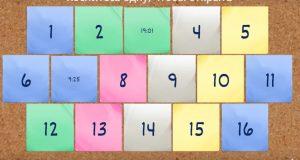
https://wordwall.net/ru/resource/29350530
You know how to tell the time. But I have some more questions for you. Let’s play “The Wheel of Fortune”. The wheel will spin and your task is to answer one of these questions.
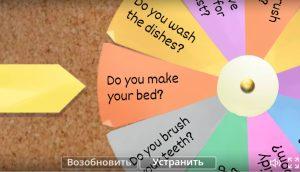
https://wordwall.net/ru/resource/30397325/english/unit-3-daily-life
2. Stage of the lesson: Announcement of the aims of the lesson (2 min)
Aims: to claim the aims of the lesson, to motivate pupils to work
You will need: To-do list (Annex 1)
The topic of our lesson is “My day”. We continue to talk about our daily life, what we do in the morning and in the evening. Look at the “To-Do List”. These are the main aims of our lesson. Look through them.
(Annex 1)
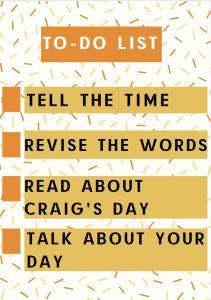
I hope that we will achieve these aims successfully! Let’s start our lesson.
3. Stage of the lesson: Checking homework (5 min)
Aims: to check the correctness of homework
Teacher’s activity: monitoring pupils’ answers
Pupils’ activity: telling the time, answering the questions about homework
You will need: handouts (Annex 2), PowerPoint presentation
Before we start our work, let’s check your home task. Your home task was to match the clocks to the times below to solve the riddle and to answer the question “What fish likes the night?”.
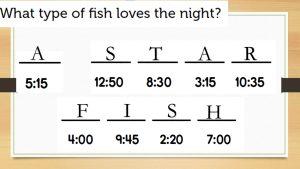
Well done, boys and girls! We have achieved our first aim “to tell the time”! Let’s put a tick on our To-do list.
4. Stage of the lesson: Vocabulary practice (8 min)
Aims: to revise the active vocabulary of the topic
Teacher’s activity: giving instructions, monitoring pupils’ answers
Pupils’ activity: putting the puzzle together, guessing the phrases by looking at the emojis, completing the table, speaking about morning
You will need: puzzles (Annex 3), handouts (Annex 4, page 2-3), PowerPoint presentation
Our next goal is to revise our active words. Look at the board. Here you see some puzzles. You need to go to the blackboard and match the phrase to the picture.
(Annex 3)

Well done! We continue to check how well you know these words. Take a look at the handouts on your desks. Do the task №1. Look at the emojis, guess the phrase and write it in your handouts.
(Annex 4 – Handout 1 and 2)
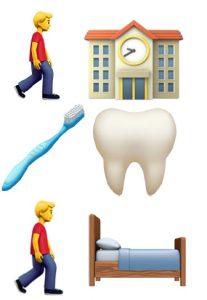
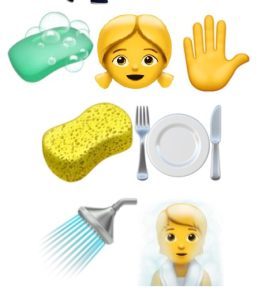
Let’s check. We will do it the following way: exchange your handouts with your classmate and put ticks and crosses. If the phase is right, put a tick. If the phrase is wrong, put a cross. Look at the screen and check.
Raise your hand if you have no mistakes. Raise your hand if you have some mistakes.
Now I see that you are very clever boys and girls and know every word. My next task will be more difficult.
Task №2 in your handouts. Look at the table and number the activities in the order you do them in your morning and speak about it.
That’s great! We achieved our second aim “to revise the words”. Now we can put a tick on it.
5. Stage of the lesson: Moving activity (2 min)
The aim of the stage: to relax, to change the activities
Teacher’s activity: giving the instructions
Pupils’ activity: following the instructions
I think we should have some rest. Let’s play the game “Simon says”. I will tell the phrase “Simon says” and add the activity. You have to do this activity. For example, Simon says get up. You have to get up.
1) Simon says “get up”
2) Simon says “do your exercises”
3) Simon says “wash your hands”
4) Simon says “wash your face”
5) Simon says “brush your hair”
6) Simon says “go to school”
7) Simon says “sit down”
6. Stage of the lesson: Work the text (7 min)
The aim of the stage: to develop reading skills
Teacher’s activity: introducing unknown words, giving instructions, monitoring pupils’ answers
Pupils’ activity: reading the text, answering the question, doing the exercise “True\False” after finishing reading
You will need: unknown words, handouts (Annex 4), PowerPoint presentation, thumbs up, thumbs down (Annex 5)
A boy Craig wants to tell you about his day. Let’s read the text and then answer the question “Is his day usual or unusual?” (Exercise 1a, page 84-85 – Source 2). But some words in this text are replaced with pictures. Try to guess the words.
Before we start reading, look at some unknown words from this text. (usual, unusual, until breakfast, go to work, a packed lunch, the sport club, do karate, fish and chips, after, usually) Let’s read them all together. (Annex 4 – Handout 3)
Now read the text. (You can find text in the document “Craig’s day”)
So, answer the question “Is his day usual or unusual?”
Now take your handouts and do the task №3. Read the sentences and mark them as true or false.

Let’s check. On your desks you can see thumbs up and thumbs down. If the sentence is true, show the thumb up. If the sentence is false, show the thumb down.
Excellent! We deserve to put a tick on our third aim “to read about Craig’s day”.
7. Stage of the lesson: Oral practice (10 min)
The aim of the stage: to develop speaking skills (monologue)
Teacher’s activity: giving instructions, monitoring pupils’ answers
Pupils’ activity: speaking about morning, evening, meals
You will need: slips of paper with situations for speaking practice (Annex 6), helping cards (Annex 7)
You know how Craig spends his day. Now I want you to talk about your day. Choose a card and speak about the situation (in the morning, in the evening, breakfast\lunch\dinner). Use the help cards as the example.
Thank you so much for your great answers. I see that you are very smart boys and girls and you lead a healthy lifestyle. Keep doing that!
We finally achieved our last aim “to talk about your day”!
8. Stage of the lesson: Assigning home task (1 min)
The aim of the stage: to show the connection between classwork and homework
Teacher’s activity: explaining home task
Pupils’ activity: writing down home task
Your home task is to make the project “My day”. Take the help cards and use them while preparing for your project.
9. Stage of the lesson: Reflection (3 min)
The aim of the stage: to reflect on the lesson, to receive the feedback from the students
Teacher’s activity: giving the instructions
Pupils’ activity: completing the To-do list
You will need: To-do list (mini versions – Annex 1)
Take “To-do list” and put ticks and crosses on each point of our aims. If you have no problems with the task, everything is clear and you can do it – put a tick. If you have some problems with this task, it is difficult for you to do it – put a cross.
Show me, please, your results.
10. Stage of the lesson: Evaluation (2 min)
The aim of the stage: to sum up the result, to assess and motivate students
Teacher’s activity: summing up the results of the lesson, putting marks
Thank you very much for the lesson, my dear pupils! You worked really hard. We achieved all the aims of the lesson! I would like to put you some marks.
The lesson is over. See you next time.



 Предложить публикацию
Предложить публикацию